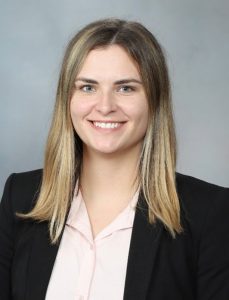By Krystal Kirby, PhD
As a newly minted diplomate of the ABR in diagnostic medical physics, I’m happy to share my journey.
My hometown of Memphis played a huge role in sparking my interest in medical physics. During my time at the University of Memphis, I got to tour St. Jude Children’s Research Hospital with the physics department; I was fascinated by seeing physics used in medicine. I was selected as an AAPM summer fellow the following year, working at Duke University doing a project on 4D cine MR for tracking tumor motion.
After earning my BS in physics and math in 2014, I started the PhD program at Louisiana State University. The coursework was challenging because some radiation physics and medical physics topics were new to me. However, LSU’s faculty are outstanding and I was able to excel in the area that I desired most – imaging, specifically MRI. I worked on side projects in neuroscience alongside my dissertation research in quantum coherence imaging, which solidified my career interest in MRI.

I attempted Part 1 of the ABR medical physics exam in my second year of grad school and failed it – this was quite a humbling experience and made me doubt whether I wanted a clinical physics career. After talking to my advisor and other mentors, however, I knew that a clinical job with research and teaching components was the right path for me. In my fourth year, I retook Part 1 and passed.
When applying for residencies, I was mainly interested in places that offered a strong research component alongside clinical work, where there would be no limits to how much I could learn. I was ecstatic to open my Match Day email and see that I had been matched to Mayo Clinic – my dream residency.
Mayo Clinic provided incredible facilities, faculty, and opportunities. I was able to delve into many clinical and research areas, such as 7T MRI and photon-counting CT, and even rotated down to their campus in Jacksonville, Florida, for a couple of months to work with physicists. During my time in residency, I was awarded the Richard L. Morin Fellowship in Medical Physics from the ACR in 2021, which was an incredible opportunity to learn more about the regulatory and advocacy efforts within radiology. I felt well prepared for the ABR Part 2 exam, which I passed in August 2022, and I had the opportunity to take the ABMRS MR Safety Expert Exam as well.
During my second year of residency, I was considering what I wanted to do for a career and I was craving something unique. I keep in contact with my LSU faculty and found that their clinical partner, Mary Bird Perkins Cancer Center, was looking to add a diagnostic physicist to their therapy team, which they’d never had. Being the first one seemed like a stimulating and challenging situation – a unique opportunity that would help me grow my career in imaging physics by doing research, clinical service, and teaching. I accepted the job and started in September 2022. Now I cover all the imaging modalities for MBPCC, including an MR linac that’s in the process of being installed. I’m also teaching and working with graduate students and summer undergraduate researchers through LSU.
My best advice for future ABR examinees is to form a study group as early as possible. I had study groups for the Part 2 and Part 3 exams, which was invaluable. Study companions offer different perspectives, while holding you accountable and committing you to study on a regular schedule. Teaching and learning from others provides critical reinforcement of knowledge. Talking with people from different backgrounds about study topics in a relaxed and nonjudgmental environment was not only great preparation for the ABR exam, but also aided my confident development as a diagnostic physicist.
Krystal Kirby, PhD, DABR, MRSE (MRSCTM) is a diagnostic medical physicist at Mary Bird Perkins Cancer Center in Baton Rouge, Louisiana. She covers all imaging modalities and specializes in MRI. Krystal has a passion for teaching graduate students and residents, and volunteers for ACR and AAPM. Her research interests include MR protocol development, MR simulation, and adaptive therapy.


